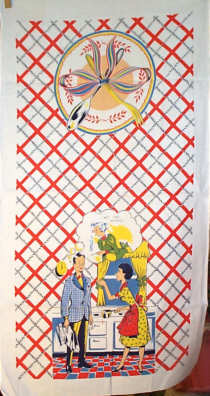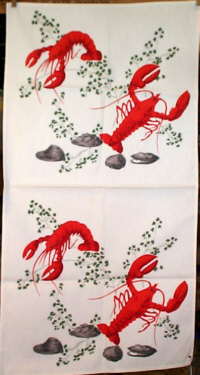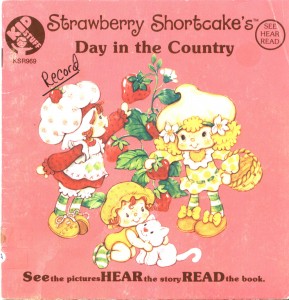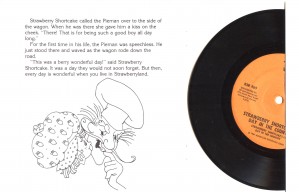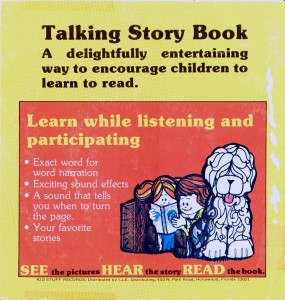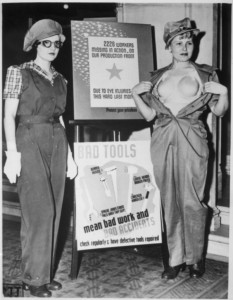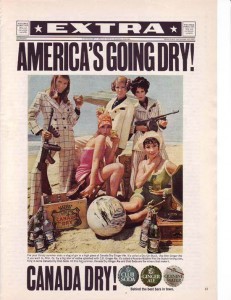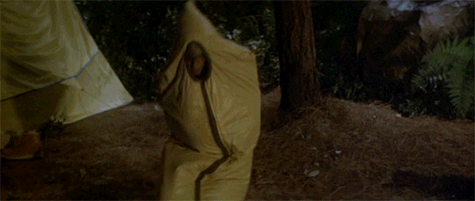Even though I skip a week every now & then, Fabric Swatch Fridays is still alive and well — but this week, we’re looking at vintage & retro kitchen towels from Rickrack.com:
Weekly Geek: Why Haven’t I Read This Yet?
I’m leaving early tomorrow morning for the weekend, and even though I had Friday’s post scheduled, when I spotted this week’s Weekly Geek question, “Why Haven’t I Read This Yet?”, it brought to mind at least one of the nagging questions raised by Gabriel Zaid in So Many Books that I just had to eek out a little time to answer it.
While Ruth at Weekly Geeks asked us to talk about a book (or books) we have been meaning to read (What is it? How long have you wanted to read it? And, why haven’t you read it yet?), my problem is far more ah, chronic than that.
In fact, I have a lovely stack of books here, desk-side, to review, read, and generally get lost in — and other stacks & sagging bookshelves for the same and other reasons.
I think sometimes my desire to own, the reality of time to read, and the love of books have given me a false sense of security when I buy books. It’s as if when I grab a book, clutch it to my bosom, and greedily pay for it, I loose all sense of reality… I cling to the fantasy of Someday.
Like all the boxes of ‘craft crap,’ I hold on to books for the great Someday when I will have time on my hands…
On one hand, this probably speaks quite a bit about of my precariously close to hoarding personality; on the other, I don’t think I’m that unique in my pursuits of piles of books.
* My eyes are bigger than my stomach — my appetite for reading greatly surpasses my time for reading.
* As a collector, writer & researcher, having my own library full of as of yet undiscovered information is a gift indeed. And, it may sound crazy, but sometimes I’m pretty sure I believe that just by owning books, by having them near, through some law of physics I will absorb all the knowledge, all the stories, all the lore & wisdom via osmosis.
* I believe in the serendipity of discovering books and the universe has blessed me with many finds; so I believe that universe will also serendipitously deliver the time to read the books (have the conversations) when I need to do so.
But mainly, I just don’t believe as Gabriel Zaid does, that “almost all books are obsolete from the moment they’re written, if not before.” I believe the opposite, actually, even though I mainly read non-fiction.
I find books from a time period often are the most accurate snapshots of the times in which they were written &/or published. Facts may be outdated, but passion & pursuit of the facts are never really outdated… Reading old books, out of print books, is to renew old conversations, illuminating so-called “current” conversations with corrections about assumptions, reminders of history lessons, and sometimes, a wisdom that’s too long been ignored or just plain forgotten. Sometimes, there’s just plain nostalgia. Maybe they are so quaint it’s funny. But saving old books, renewing previous conversations, remembering that this “now” we think is so important will also pass, is vital in my world view.
If it doesn’t matter to me how much time has passed between when the book is written & when the book is read, how can it matter how much time passes between when you bought a book & when you read it?
Basing your reading on “new only” or some inventory mantra of “first in first out” is an anathema to me. It conveys a materialistic aspect, diminishing books to temporality, objects limited to a short time of significance. As a collector, as a researcher, and as a reader I completely disagree.
And I have the stacks of as of yet unread books to prove it.
Cheap Thrills Thursday: Lessons In Literacy With Strawberry Shortcake
Let’s see… When this Kid Stuff Records book (copyright 1980) & record (copyright 1981) set of Strawberry Shortcake’s Day in the Country came out, I would have been 16 or so, which naturally explains why I never owned any Strawberry Shortcake stuff back in her heyday. Why the stuff seems to gravitate towards me in some sort of kitschy retro-grade, is a complete other issue — like Smurfs, for which I have no sense of nostalgia either, I do not yet know why.
Anywho, I grabbed this SEE the pictures HEAR the story READ the book set for about a buck, as I recall, making it another cheap thrill.
But, like most things I touch, it provokes a few questions…
Why were the pages merely black & white pictures? Were you also supposed to COLOR the illustrations?
More profoundly, I wonder what’s become of the progression of these kids’ books… When my eldest was little, the book & record sets had morphed to book & tape cassette sets, then to those (incredibly annoying) books with the computer chips that made noises (whenever you saw the icons in the text, you pressed the corresponding button for an audio clip). And now, the closest things I’ve seen are the video games which mainly use “pens” to read the words or stories (or, sometimes, have buttons much like those electronic books).
If the concept was based on the philosophy that being read to encourages children to become readers (and these book & audio sets were to assist parents who, for whatever reason, had no time to read to their children), then I think that’s been lost along the way. Lost with the interactivity — broken down into amusing “fun” and sold as “learning” yet.
As Gabriel Zaid (and translater Natasha Wimmer) so eloquently & concisely described in So Many Books, reading is a very complicated learned process involving the interpretation & integration of units of complex meaning into a cohesive whole. This is why listening to stories is so powerful — it is more natural, more easily intellectually and even emotionally digested. But once hooked on stories, a person wants to have the independence to select & enjoy on their own; they develop the love of reading.
So why add further fragmentation to the process? Why break reading down into even more chunks, such as distracting gimmicks of auditory bells & whistles? Why add other activities to it, such as pushing buttons, touching screens, using wands — removing one’s focus not only from the story as a whole but the page itself?
Quick, Check Your Stone Tablet For The Date!
A recent study reports that today, in 2009, 71% of Americans think women should take their spouses name after marriage — and half of the respondents said the act should be a legal requirement!
Researchers from Indiana University and University of Utah say these findings come despite a clear shift to more gender-neutral language. “The figures were a bit sobering for us because there seems to be change in so many areas. If names are a core aspect of our identity, this is important,” said Brian Powell, professor of sociology at IU Bloomington. “There are all these reports and indicators that families are changing, that men are contributing more, that we’re moving toward a more equal family, yet there’s no indication that we’re seeing a similar move to equality when it comes to names.”
Laura Hamilton, the Indiana University associate professor who lead study, was interviewed at NYDailyNews:
When the respondents were asked why they felt women should change their name after the wedding, Hamilton says, “They told us that women should lose their own identity when they marry and become a part of the man and his family. This was a reason given by many.”
Other respondents said they felt the marital name change was essential for religious reasons or as a practical matter.
“They said the mailman would get confused and that society wouldn’t function as well if women did not change their name,” Hamilton says.
Americans who feel that women should take their husband’s last name also tend to be conservative in other areas, according to Hamilton.
“Asked if they thought of a lesbian couple as a family, those who believe that women should take their husband’s name are less likely to say yes,” she says. “If you’re more liberal about the name change issue, you tend to include a larger population in the definition of family.”
Dating Advice From The Past (Or Female Dating Snark, 1940 Style)
This article, written by an anonymous female, was published in The Bedside Esquire, 1940 — just see how well it holds up today *wink*
The Wench Is Not Amused, by Anonymous
Any girl, if the body she possesses isn’t actually deformed and the face badly moth-bitten, is going to become acquainted with the gentle art of seduction fairly early in life. As for myself, I’ve had what I now recognize as more than my share of experience.
Not at the risk of sounding vain, because I know I am vain, I’ll say that when men look at me in the street I know why. They’ve good reason to. In 1930, when the agency I was working for folded, I posed for several commercial photographers. I’ve seen strange men studying my picture in a magazine and, though their eyes generally started at the ankles & worked up by degrees, I’m pleased to admit that they looked twice at the face, too. And I’ve read a book, I dance well because I love it, I know how to listen as well as talk, I can tell a touchback from a safety, I can hold my likker as well as my men – when I want to – and I know most of the right words. I seldom buy my own dinner.
I know it sounds conceited as the devil but, darn it, it’s true. I’ll lay twenty to one I can make any nine out of ten males, provided they are neither puling infants nor doddering antiquarians, ask for my phone number within any given half-hour.
So, when I say I’ve had more than the average experience with the technique of seduction (horrible phrase) I think I’m stating a simple truth.
When a gal is first turned loose on the world of man the game of seduction – win, lose or draw – is pretty exciting. And it continues to be for some years. At first, either your parents or your school keep you under observation & your only exposed to younger men. Their approach, naturally, isn’t as polished as that which you’ll encounter later. Also, the fact that you are under some sort of surveillance means that you’ll be exposed only occasionally & for brief periods of time & not to the extensive & intensive campaigns you’ll have to face when you become what is so quaintly known as a bachelor girl. During my lat four years of school, a year abroad, & my first three or four years in New York I must admit that I thoroughly enjoyed the whole tiresome process; particularly so when I learned that, so long as I kept my head, the game could be played according to my own rules without ever hurting the boy friend’s sense of masculine superiority in the least.
It was always a thrilling battle & the campaign itself was often more exciting than the storming, or attempted storming of one’s last citadel. How many times I’ve lost in this warfare is entirely a matter of my own business. But I will say this: no campaigner, no matter how hardened, ever overcame my last line of defense unless I deliberately chose that he should – and that can hardly be counted a total defeat.
In the past year, sadly enough, I’ve come to realize that what was once an enthralling game is now a deadly bore. And I contend it’s all the men’s fault. A seduction should be above all things glamorous & exciting. But can there be glamour in a story repeated a dozen, yea a hundred times? Can glamour be expected to survive the hundredth ardent whisper of non-poetic time-worn words? Can there be excitement in a card game played eternally, with both players forever holding the same cards? There cannot!
Why don’t men vary their approaches? Damn it, haven’t they any originality? Must they be so monotonous?
Why is it that each man has at his command three or four of the seven standard approaches to seduction & selects his approach according to what he fondly believes to be his shrewd analysis of the character of the wench he is lusting for?
This is all wrong. And something should be done about it. Why don’t men realize that an injection of originality or novelty into their love-making will get them further with the gal of their temporary choice than any pet phrases or standard passes the gibbering idiots can produce?
Repetition is so damn boring. The fun is all gone if, after the first kiss & the first declaration, you can, from past experience, anticipate practically every word & gesture that is to follow, be it a one night stand or a three week siege. And that isn’t right – sex should be fun.
If you’re a girl who hasn’t given this matter any objective thought, stop now & take stock. You’ll be saddened & disillusioned to see what well-worn ruts your young men pursue.
And you, lad, believing yourself to be a Casanova as you do, cast your eyes over the following catalog – and blush for your sex’s limitations. Blush, too, for yourself, for you have nothing more on the ball than any other man. You’re unoriginal & trite. That swell build-up you were planning to use tonight & which you rather expected to send darling little Jean into a swoon will be the same build-up John used on her two months ago, Paul the week before, Ronald last year, and so on back to the days when she bought her first lipstick & lace panties. And you actually expected her to fall for it tonight? Fooey! Those girlish peals of laughter will probably be at you, rather than with you. But you have only to get yourself a new approach, my lad, really new, and your path will be paved with recumbent maidens.
The following list contains what I’ve found to be the seven fundamental approaches. There are, of course, variants but they are all variants of these basic seven. At least, my own experience & the experience of attractive girls I know leads me to believe that this is a complete list. If it isn’t, I’ve been neglected & I resent that. And if the young man will step forward to present credentials proving that he is in possession of an Approach Number Eight I’ll be glad to meet him on his home grounds, winner take all.
Approach One
The Crudest Simple, and very raw. The idea is for the male to ply you with likker until you lose control. The man who uses this approach is obviously a louse, obviously without resources, and so unsubtle that he is easily seen through & a cinch to out-smart. This technique is so bad it doesn’t merit serious discussion. The only ones who will succumb to this attack are the completely foolish, those who are particularly light-headed drinkers & potential nymphomaniacs.
Approach Two
The Cheapest As crude in its way as One. This man tries to get at you through passionate declarations of love. He may even plead with you to marry him, sometimes soon. Meanwhile, sine you are already man & wife in the eyes of God or, at the very least, two hearts that beat as one – how about it? The man who uses these tactics is probably an even greater louse than the likker-plying-male. The ‘I-love-you’-chanted-soulfully method will succeed only with susceptible virgins (any age) and those stridently emotional wenches of meager intelligence whose metier in life is rocking the cradle. The gal who has been around will merely enjoy her laugh, when approached in this manner, and promptly send the man back to the minor leagues, where he belongs.
Approach Three
The Ham-iest The long-bearded ‘misunderstood husband’ gag. No elucidation is needed. Only fools fall for this chestnut & it is doubtful if, after falling, they deserve any sympathy. It has been my experience that married men are seldom worth the trouble. It is generally wisest to send them home to the little woman, in short order.
Approach Four
The Outright Purchase Like the Greeks, they come bearing gifts; generally expensive & so tendered that it is possible for the semi-prostitute to accept her wages without feeling too professional. The man who pulls this one isn’t fooling. He means business & wants it tacitly understood that there are to be no strings attached to this business deal. And he is intelligent enough to know that the average female is capable of very long distance rationalizing & thus can graciously & righteously accept a fur coat or a diamond ring whereas would regard the offer of actual cash as a terrific insult. This system, probably because it has sound economic & not emotional basis, is liable to work with any of us who haven’t been an heiress. If the man is anywhere near as attractive as his gift it is sometimes necessary for a gal to summon up her last bit of will power to say ‘No.’ But it usually is worth it, if only to preserve those few remaining shreds of self respect.
Approach Five
The Big Brother Act This predatory gent is an insidious operator where the unwary female is concerned. In the first place, he is patient. This, in itself, is usually enough to throw you off. He starts off on a ‘just friends’ basis & worms his way into your heart as a confidant & pal. Before you know it you are, on those odd nights, telling him all about your joys or sorrows with whichever Tom, Dick or Harry you are at the moment involved. He is very sweet, sympathetic & understanding. But he is playing a waiting game. He knows that eventually, human nature being what it is, there’ll be a bust-up between you & the boy of the moment… and when it comes you’ll find his broad shoulder there for you to weep on. You weep & you weep. You’re on the rebound & desperately in need of masculine comforting. And suddenly you find that you’re getting it in a very big, and totally unexpected way. And because you are weak & blue& emotionally drained & in need of some male tenderness you all at once become aware of the fact that your Big Brother is is much sweeter & more desirable than you had ever found him to be before. And if he realizes this at the same time that you awaken… you’re lost. When he puts on the pressure you’re defenceless. I know that this approach depends upon extenuating circumstances but they occur far more frequently than one ever suspects. And a girl on the rebound is in no fit condition to put up an adequate defence. My only solution is this: never trust a man who tries to build up a platonic friendship with you. At the time it may seem to you that it would be such a relief to know a man like that, but you can with impunity bet your last garter-belt that you’re wrong because, some place in the back of his mind, he’ll have an idea or two…
Approach Six
The Pseudo-Sophisticate This approach has three subdivisions but they are all based on the same fundamental sophistry: 6-A. The Philosophical. The life-is-real, life-is-earnest, opportunity-knocks-but-once, so grab-each-fleeting-moment-while-you-may school. This is, of course, the veriest hokum, fit only for children in their teens. Every woman beyond the age of adolescence knows that this unique opportunity the gentleman is so magnanimously offering her is an opportunity that knocks all too damn frequently. Why any man who isn’t completely witless ever thinks a girl will believe him to be the only one who will ever offer her a chance to indulge in a life of sin is beyond me. So, girls, the nest time a man pulls this, ‘Tonight is ours!’ line on you, control your laughter, let him down gently, and send him on his way. The stronger sex? Physically, yes.
6-B. The Pagan. This lad is likely to have long hair. He has read Ulysses and has a glib knowledge of neo-realistic painting or something of that sort. He thinks very highly of individualism & quote Nietzsche’s remarks about the Superman (himself). he tells you that the old, conventional moral standards of our fathers are outmoded (news to you?) and insists that today we see such things as sexual relations with a new vision, a proper perspective. ‘After all, we want each other, and what is going to stop us?’ he asks. ‘Aren’t we free people, free to live our own lives?’ You are also free to point out to him that ‘we want each other’ is taking altogether too much for granted. You explain, in as tactful & gentle terms as the situation requires, that a fairly ardent kiss or two, permitted in a moment of weakness, doesn’t exactly establish the fact that you are willing to turn over the body beautiful. He’ll never believe, of course, that it wasn’t your inhibitions which prevented you from succumbing & he’ll go on his way, still proud of his free & soaring spirit, in search of a girl with low heels & spectacles, who thinks Communism would be nice. And he’ll say to her ‘Look at Russia,’ and get away with it. I don’t want to look at Russia. Blouses & smocks? Not with my torso.
6-C. The Physical. Whereas the first chap in this category went at you on a philosophical plane, so-called & the second tried to weaken you on a moral & individualistic grounds the ‘Physical’ lad goes to the root of the matter & attacks you with body blows. His weapons are psychiatry, Freudian psychology & your glands. These physical realists always have your well being at heart. They explain at great length that sex is an appetite which must be satisfied if one isn’t to become a victim of all sorts of fetishes & suppressed desires. Now, no girl would want to become amorous in public with Shetland pony or become addicted to horsewhipping her grandmother. It isn’t being done. The obvious solution is to permit whichever physical realist is at the moment spouting his propaganda to come between you & the tragedies of perversion. The whole affair is, of course, to be considered in your own best interests.
We may very well be animals & victims of appetites which must be satisfied in order to prevent complexes & frustrations. I’m willing to admit that the boys may have something there. But, so far, I’ve been able to order my own meals & I think I’ll continue to do so. When I’m hungry I’ll eat, if the proper food is available, and no one is going to force improperly prepared food on me when I’m not hungry… and my grandmother will have to take her chances.
Approach Seven
The ‘Forcing’ Method Or perhaps I should call it the cat-and-mouse attack. In any event, the glib gentleman who works this approach on you is primarily concerned with forcing you to make the final move and ‘Safety First’ is obviously his motto. The opening lines generally read something like this, ‘I don’t love you & I know you don’t love me – but I can’t help wanting you. Why pretend? I think you’re swell – sex excluded – but you’re so damned attractive that, no matter how hard I try, when I’m with you I want you.’ Then he adds, oh very frankly & fairly, ‘I like you so much that I have to be honest with you. If I continue to see you I’ll make love to you, I can’t help myself. If you want me to stop coming around, now that you know, you’ve only to say so.’ The catch in this last speech is that he only produces it when he is pretty damn sure that you like him a lot & enjoy being with him. Of course you, liking him as you do & feeling on safe terrain because he hasn’t so much as touched you, laugh it off & take your chances.
But after a night or two of conversation in the same vein but growing progressively more intense, the chances are that he will kiss you: ardently, of course, and probably with considerable finesse – and you’ve given the inch that may coast you your virtue.
Gently & insidiously the campaign progresses. Each night it will become a little more intense & each nigh your defences will fall back and inch or two. But he will never use force, never put on an any obvious pressure. Each time you feel called upon to say ‘Stop,’ he’ll stop – to your growing annoyance. And, though you probably won’t realize it, that is one word you’ll come to use less & less frequently.
Slowly & inevitably the tide, to use a figure of speech, creeps up & up until that night when you’ve forgotten even the meaning of the word – and then the louse stops of his own accord!
The speeches at this point are liable to be on the impassioned side & to deal at some length with his desire for you & your many darling qualities & so on far into the night. Eventually he gets around to asking you if you, too, desire him. After what has just transpired you wonder of he is a complete idiot, then reassure him in your own subtle way.
This generally calls for a clinch & the addition of fuel to the flame. After a proper interval he pulls the Remorse-stop. It goes something like this & is generally delivered in a somewhat throaty voice, ìI want you sooo much (pause) but I can’t let you do this unless you are sure in your own mind. We’re excited now, my dear, (He’s telling you!) and I wouldn’t want you to do anything you’d later regret. I want you more than anyone I’ve ever known, (this is standard: note careful evasion of the word love) but this is too beautiful an adventure to rush into headlong.î While you’re wondering just how he would have you rush into said adventure he makes a suggestion, ‘Sleep on it tonight & think it over in the clear light of day, tomorrow. We’ll meet for dinner, and then you can give me your decision.’
You agree, and this leads to another scene that wouldn’t get by the Will Hays’ office & considerable incoherent & what he thinks is poetic talk about how much he hopes you’ll feel tomorrow night as you do tonight.
Then there is much discussed sleep & ‘thinking (if any) in the light of day.’ It would serve the gent right if the daylight led to a decision he wouldn’t like but for some darned reason it seldom does.
When you meet him the next night he is pretty solemn about the whole thing (but you can be sure he’ll give you the best dinner he can afford, with a rather obvious emphasis on the wine list). Once you get back to whichever apartment is the scene of combat you’ll find that tenderness is the preliminary mood of the evening. He may not use his arms & hands as they were intended to be used as all, but if he does he’ll be very, very gentle. In desperation you finally take him by the hand, figuratively speaking, and lead him to the bedroom.
It may be several days before you begin to realize that you’ve been had in more ways than one. And if this realization doesn’t come to you shortly you are in an even worse position because you’ve been had so thoroughly that your heart may well be in your young man’s hands – and that is one section of your anatomy which should remain permanently yours.
There is a mild variant to this approach. In this method the man, at the critical point, doesn’t suggest a little daylight thought on the subject but, instead, goes dramatic & says, ‘No, this can’t be. The price you pay is too large,’ or words to that effect. It works out in exactly the same way. One says, ‘Perhaps.’ and the other says, ‘no,’ and in the end you are unconsciously forced into taking them both by the hand…
This is probably the most difficult form of seduction to work clear of – because you’ve been allowed to work yourself into it.
These are the standardized versions of sexual Blind Man’s Bluff, Tag, You’re It, or whatever you want to call it, as I know them. There are probably other, depending on race, color or previous condition of servitude but I wager that they are in their way just as standardized. What to do about it?
Sometimes I think I’d rather be attacked. Or at least meet a man direct enough to say bluntly & without preamble, ‘I think you’re swell & I’d like to make love to you. I warn you, if you say no I’ll ask you the same thing tomorrow night. What will it be, milady’s boudoir or the movies?’
The hell of it is, experience has so conditioned me that I’d probably choose the movies & be forced to sit through a Hollywood version of the preliminaries of one of the stereotyped brands of seduction I’ve listed. There’s no escape.
New Vintage Reviews #5
Welcome to the fifth edition of the New Vintage Reviews Carnival, where we review “old stuff” that is likely new to someone… And (most of the time) it still has great entertainment value!
Please submit your blog articles to the next edition of the blog carnival using the carnival submission form.
Games:
At Collectors’ Quest, Collin David posted Batman Vs. Video Games: Part Two.
I review Q*Bert, the board game, here at Kitsch Slapped.
Film:
Cliff Aliperti reviews Alfred Hitchcock’s The 39 Steps over at NY Classic Movies Examiner.
Aero Vintage reviews the documentary Black Jack’s Last Mission.
Here at Kitsch Slapped, I wrote about Bathing Beauty (and the joys of TCM).
Jaynie, of Here’s Looking Like You, Kid, says if you love shoes, you’ll love in The Lady Eve.
Travel:
At Kota Medan Guide, there’s information about & photos of Tjong A Fie Mansion.
Books:
Sarah Sammis reviews Over Sea, Under Stone from The Dark is Rising series by Susan Cooper over at Puss Reboots: A Book Review a Day.
Aero Vintage reviews Fly A Big Tin Bird.
Honorable Mention:
If you love vintage games, check out Slashdot’s review of Vintage Games: An Inside Look at the History of Grand Theft Auto, Super Mario, and the Most Influential Games of All Time.
I give some tips on being thrifty and looking for antique, vintage & used irons at your local thrift shop.
What Can Be Learned From Chris Brown’s Light Sentence?
By now you’ve probably heard how Chris Brown barely got his hand slapped for beating up Rihanna; just probation, community service, domestic violence counseling, and a restraining order. This for a man who, as reported by CNN, had two earlier incidents of domestic violence with Rihanna before the more publicized incident in which Brown punched Rihanna numerous times; put her in a head lock, restricting her breathing and causing her to start to lose consciousness; bit her ear and her fingers; and threatened to kill her.
Rihanna’s injuries included cuts and bruises inflicted by a large ring on Brown’s right hand, which he used to punch her, the probation report said.
“Officers at the scene observed numerous contusions and abrasions to the victim’s face and forehead, as well as bruising to her left arm near the bicep,” it said. “They also saw abrasions to her arms near both wrists and on her upper chest near her collarbone and around her neck. There were abrasions on her left leg and on the inside of her upper lips.”
If you want to know how such atrocities can be met with such a lazy legal response, keep reading here at Relationship Underarm Stick; we’ll be going through this subject in great detail. For now though, you may want to consider this poor court response of little consequence to Ryan Jenkins. He had a history of domestic violence & he too was allowed to be free — and he killed Jasmine Fiore. Rihanna should remember this anytime she even considers letting Brown break that restraining order.
This Just In… Timeless Television
When I’m not busy killing squirrels & scaring neighbors, I’m researching & writing from home — in between the usual parenting & home life disturbances.
 Today, while researching a vintage plastic donkey (don’t worry, you’ll hear about it all later), I am absentmindedly aware that my son has left the TV on and that an old episode of The Family Feud is playing on GSN.
Today, while researching a vintage plastic donkey (don’t worry, you’ll hear about it all later), I am absentmindedly aware that my son has left the TV on and that an old episode of The Family Feud is playing on GSN.
It’s that final round, and it goes like this:
Richard Dawson: Name something that little boys like that little girls don’t.
Male contestant: Balls.
The audience snickers through the rest of round.
I do believe that when it came time for the “survey sez” that “balls” got bupkiss. But that’s not the point, now, is it.
Whatjamacallit Wednesday: What’s Left On Thrift Store Shelves May Not Be Anything To Write Home About, But…
What sits on thrift store shelves is quite telling about “us” as a society. On a recent visit to a thrift store, I found proof that we just aren’t writing letters anymore — and if we are, we don’t care so much about how well they are written.
Discarded & donated, two copies of different “how to write letters” books: Standard Book Of Letter Writing & The Someone Cares Encyclopedia of Letter Writing.
Why Women Opt To Remain Single
A woman goes out with her friends, meets a guy named Dmitri and they talk for “at the most 2 minutes.” She hands him her business card and says call me… These are the voicemails he leaves her (with some images added for video appeal):
[youtube]http://www.youtube.com/watch?v=c06pinaKl8o[/youtube]
Sign Of The Times: 1943
You’ve heard of safety shoes, right? Well, here’s a safety bra straight out of the history books of home front WWII.
Via The U.S. National Archives at Flickr, the original caption reads: Safety garb for women workers. The uniform at the left, complete with the plastic “bra” on the right, will prevent future occupational accidents among feminine war workers. Los Angeles, California. Acme, ca. 1943.
Ryan Jenkins Dead; Long Live Domestic Violence
The case of Jasmine Fiore’s murder gets even more upsetting as Ryan Jenkins is found dead from an apparent suicide in a hotel in Vancouver.
That a man would kill his ex-wife and commit suicide isn’t, unfortunately, so strange; but what’s being said by the manager of the Thunderbird Motel (in Hope B.C.) where Jenkins’ body was found is. The room was paid for by an unidentified woman (some speculate that it was Jenkins’ former girlfriend, Paulina Chmielecka) who only stayed at the hotel for about 20 minutes before leaving Jenkins behind. What follows is the sort of 15-minutes-of-fame-seeking commentary that you’d expect, such as “when I opened the door, I did smell the smell of death” and then the stuff that Jenkins supporters will take & make a grand conspiracy theory of:
The manager went on to tell reporters that the woman was “extremely calm” when she checked in, that there was no suicide note that he saw, and that Jenkins’ feet were touching the ground as he hung, which would indicate a sedative of some sort may have been used during the suicide.
Anyway, while Fiore’s mother & former boyfriends mourn the loss of the young woman and express anger that Jenkins has escaped answering for what he’d done, Jenkins’ family is also telling their story in the media. And what I’ve read is most upsetting.
Naturally none of us wants to believe the people we love are capable of such things, of murder & violence, but when that person has been found guilty on more than one occasion, as Jenkins had, you have to stop living in denial — and being an asshat.
In this interview, Jenkins dad, Dan Jenkins, told this to the Edmonton Sun:
What Jenkins refuses to believe, despite Ryan’s past conviction in Calgary for domestic abuse, is that his son was the only villain in a relationship gone bad.
“A lot of these things were just silliness, like the charge in California,” said Jenkins.
Ryan was arrested on a charge of domestic violence earlier this year, after allegedly slugging Fiore in the arm.
Jenkins says his son only pushed his wife into a pool, after a squabble.
“He felt like it was a police state. People push each other in the pool every Saturday afternoon, and he goes to jail for two days — that’s ridiculous,” said Jenkins.
“He turns around and his wife’s kissing another guy and he grabs her hand and starts walking away, and they’re arguing and he just pushes her in the pool. Well, big deal.”
Hey, daddy Jenkins, abuse isn’t “silliness.” Pushing a woman, into a pool or not, no matter who or what she kissed, is a big deal. Gee, I wonder where sonny boy got the idea in his head that it was OK to be abusive towards women.
Dan Jenkins interview continued:
Jenkins said his son’s relationship with Fiore, and Hollywood in general, was toxic.
“He went to Hollywood and something down there in the last four months, including this girl, just destroyed him,” said Jenkins.
“She would take off for days at a time and lie, and Ryan was lonely and distraught and alone down there. She was his only friend and she’d just disappear.
“It was hell on earth — I advised him 50 times to get out of that relationship.”
So he realizes the relationship was toxic, and said that he told his son to get out of it, but where does Dan Jenkins leave the blame?
On the victim.
Hasn’t Fiore paid enough?
Jenkins must be held accountable for his violence, even in death. And Dan Jenkins isn’t dead — he must be held accountable for his inexcusable misogyny. Isn’t he as much an accomplice as anyone who may have helped Ryan Jenkins kill Jasmine Fiore &/or helped him afterwards? I certainly believe daddy dearest is.
In a rare show of class for VH1, the channel has pulled both reality shows in which Ryan Jenkins participated. Too bad they didn’t have the sense to have properly vetted Jenkins in the first place.
Romantic Pillow Talk – Of A Different Sort
Remember practicing kissing and caressing your pillow when you were a teen? Well, there’s a whole movement dedicated to romancing the pillow and other two-dimensional objects in Japan.
According to Lisa Katayama in the New York Times Magazine, there’s a fraction of men in Japan who adopt body-pillow girlfriends and other “2-D” lovers as a substitute for real relationships. These men take their pillow girlfriends out on dates to restaurants, to sing karaoke, to take photo-booth pictures — positioning their stuffed girlfriends gently, “making sure to keep her upright and not to touch her private parts.”
The guru of the 2-D love movement, Toru Honda, a 40-year-old man with a boyishly round face and puppy-dog eyes, has written half a dozen books advocating the 2-D lifestyle. A few years ago, Honda, a college dropout who worked a succession of jobs at video-game companies, began to use the Internet to urge otaku to stand with pride against good-looking men and women. His site generated enough buzz to earn him a publishing contract, and in 2005 he released a book condemning what he calls “romantic capitalism.” Honda argues that romance was marketed so excessively through B-movies, soap operas and novels during Japan’s economic bubble of the ’80s that it has become a commodity and its true value has been lost; romance is so tainted with social constructs that it can be bought by only good looks and money. According to Honda, somewhere along the way, decent men like himself lost interest in the notion entirely and turned to 2-D. “Pure love is completely gone in the real world,” Honda wrote. “As long as you train your imagination, a 2-D relationship is much more passionate than a 3-D one.” Honda insists that he’s advocating not prurience but a whole new kind of romance. If, as some researchers suggest, romantic love can be broken down into electrical impulses in the brain, then why not train the mind to simulate those signals while looking at an inanimate character?
Many single people here in the US might find some of this quite reflective of the culture here; only the display of physical substitutes for romance are less accepted here.
In Japan the fetishistic love for two-dimensional characters is enough of a phenomenon to have earned its own slang word, moe, homonymous with the Japanese words for “burning” or “budding.” In an ideal moe relationship, a man frees himself from the expectations of an ordinary human relationship and expresses his passion for a chosen character, without fear of being judged or rejected.
“It’s enlightenment training,” Takuro Morinaga, one of Japan’s leading behavioral economists, told me. “It’s like becoming a Buddha.” According to Morinaga, every male otaku can be classified on a moe scale. “On one end, you have the normal guy, who has no interest in anime characters and only likes human women,” he explained. “The opposite end, of course, is the hard-core 2-D lover.” Morinaga, a self-described otaku, didn’t have much luck with women until he became a well-regarded economist. Now he has a wife and a private office in a fancy apartment building near ritzy Tokyo Bay. “I’m a 2 — I still like human women better,” he said, a wide grin forming. “But there are many men who are on the opposite side of the scale. I understand their feelings completely. These guys don’t want to push ahead in society; they just want to create their own little flower-bed world and live there peacefully.”
Aside from the large scale physical display & touching, is this any different than the romantic fantasy of soap operas, romance novels, films like Twilight, etc.? I don’t think so. Retreating to a fantasy, love doll, pillow, erotic story ,or dreaming of your own vampire lover is just as sane — or insane, I guess.
Can any be replacements for real human relationships? Can Twilght fandom, eating chocolate, or profuse shopping be as emotionally satisfying as dating? Can rapid page turning of bodice rippers, caressing of printed pillows, or vibrators be as satisfying as real human contact?
Maybe not; but as long as you can tell the difference, know reality from fantasy, they can’t hurt you as badly as divorces, break-ups and rejections either.
That said…
I am creeped-out by the Japanese penchant for underage girls. Most of the Anime characters & other pillow girls seem to be pre-teen & teenage school girls. While that’s disturbing & debatable on it’s own, I don’t find anything wrong with the idea of pillows or 2-D romance per se.
…It’s a bit sad, but no sadder than the girl who buries her nose in a succession of Harlequin romances, downs her emotions in vats of chocolate, etc.
An Ugly American Watches A Beauty Pageant
After an incredibly busy & exhausting weekend (this was just part of it), I spent a few hours just loafing on the couch Sunday night. Channel surfing, I happened upon the Miss Universe Pageant — I wouldn’t have watched, expect for they were announcing that the female part of Spidey, Heidi Pratt, would be performing a song. Like Scooby-Doo, I say, “Guh?!”
She can’t sing’ she can’t dance — she can barely put more than three moves together & looks like a clomping horse (no offense meant to horses!) while doing it. Don’t believe me? Watch it.
But by the time her performance was over, I was hooked on the train wreck qualities of the show.
Aside from Dean Has-been Cain (and Heidi, who I wish would just go away) the only person I recognized was Tamara Tunie — which surprised me because I’ve always seen her play intelligent women (a lawyer on As The World Turns; a coroner on Law & Order: Special Victims Unit). When Tunie and others asked their questions, they did try to bring up important issues:
- Should AIDS testing be mandatory?
- How does it feel to compete in a pageant wearing a bathing suit when some women are not allowed to wear bathing suits?
- Are women equal to men?
- Has being beautiful meant you have been taken less seriously as a business person?
Watching the contestants struggle to not answer the questions, to avoid the meat of the issue, was painful. It would be easy to call them robotic Stepford wives, but honestly, how could any of them answer the question directly (let alone honestly) and win the competition?
Watching them give placid answers designed to inflate the room’s already high testosterone levels was to witness a horrifically powerful thing.
http://www.youtube.com/watch?v=_-LF9Y4SqdU
It reminded me of the unspoken issues we women have to keep mum about — or risk loosing what places, ground, we have as well as those we aspire to. Watching beautiful young women play that game in a pageant setting was astonishing. Especially in front of La Donald, Mr. Trump. :shudder:
But there was plenty to enjoy too — if your enjoyment, like mine, tends towards the perverse.
I enjoyed the fact that at least one contestant didn’t take not moving on up with the ever shortening list of finalists as gracefully as she’s supposed to. Look at Miss Switzerland’s sad slump of despair!
I enjoyed watching when Miss Venezuela won — making “history” by giving back-to-back wins for Venezuela in the Miss Universe Pageant — and the former Miss Universe was so excited that she threw the 2009 Miss Universe crown off & over the winner’s head. (This is different coverage than I saw, but you’ll see the crown fumble — and note the unfortunate caption “clinches the tit” as the word title is shortened.)
In looking for photos from last night’s pageant, I found a great number of complaints about the racism in the Miss Universe pageant — especially with regards to Asian women. I haven’t watched a beauty pageant in probably 30 years, so maybe I shouldn’t take the claims as true… But it sure looks like nothing has changed. Except for the internet providing more place for public outcry against the Miss Universe Organization, predictions of which countries will no longer participate, and viewers vowing to switch to other pageants like Miss World.
If I am allowed to make one “purely girlie” observation (one more likely to please La Donald), it’s that Miss Kosovo, Marigono “Gono” Dragusha, is nearly as externally beautiful as Audrey Hepburn. Not only does she physically recall Hepburn, especially around the eyes & in her ball gown performance, but I believe she had stated that she intends to become a counselor to help children affected by the violence in her country. (Miss Kosovo finished as the 2nd Runner Up, aka 3rd place.)
I don’t have any plans to watch another pageant; but then again, I didn’t plan to watch this one… I do think checking in every 30 years or so might just be enough.
Breast Implants Identify Murder Victim
Playboy model Jasmine Fiore has been found murdered. Her body was badly beaten & naked, left in an Los Angels trash bin on Saturday — her fingers & teeth “forcibly removed” in an apparent attempt to not have the body be identified, but her remains were identified by the serial numbers on her breast implants. (Now there’s something many feminists don’t know about the benefits of breast implants!) The preliminary coroner’s report indicates that Miss Fiore was strangled.
Her former husband, Ryan Alexander Jenkins (formerly a contestant on VH1’s reality show Megan Wants a Millionaire) is wanted for questioning. You can read all the details here; but here are some of the warning signs people should have heeded:
Court records show that Mr Jenkins was charged in June in Clark County, Nevada, with a misdemeanour count of “domestic violence” when he was accused of hitting Miss Fiore on her arm.
Mr Jenkins was also charged with assaulting his girlfriend in July 2005 in Calgary and given a conditional discharge with 15 months probation.
I may have more to say about this; but I have to go cry & throw-up first.
Just Who Destroys Books & Libraries?
 After reading So Many Books: Reading & Publishing in an Age of Abundance, I was delighted to serendipitously discover a copy of A Universal History of the Destruction of Books: From Ancient Sumer to Modern-day Iraq, by Fernando Baez (translated by Alfred MacAdam), staring me in the face from the “new arrivals” display at the public library.
After reading So Many Books: Reading & Publishing in an Age of Abundance, I was delighted to serendipitously discover a copy of A Universal History of the Destruction of Books: From Ancient Sumer to Modern-day Iraq, by Fernando Baez (translated by Alfred MacAdam), staring me in the face from the “new arrivals” display at the public library.
I’ve always wondered just who would destroy books and libraries — and why. Here was my chance.
The book’s Introduction sums it up best:
It’s common error to attribute the destruction of books to ignorant men unaware of their hatred. After twelve years of study, I’ve concluded that the more cultured a nation or a person is, the more willing each is to eliminate books under the pressure of apocalyptic myths. In general, biblioclasts are well-educated people, cultured, sensitive, perfectionists, painstaking, with unusual intellectual gifts, depressive tendencies, incapable of tolerating criticism, egoists, mythomaniacs, members of the middle or upper classes, with minor traumas in their childhood or youth, with a tendency to belong to institutions that represent constituted power, charismatic, with religious and social hypersensitivity. To all that we would add a tendency to fantasy. In sum, we have to forget the stereotype of the savage book destroyer. Ignorant people are the most innocent.
You could take that at face value — but I preferred to continue reading how Baez came to that conclusion.
In the Note for the English Translation, Baez suggests the following:
I suggest not reading it beginning-to-end because, in its way, this book is an anthology of possible books. The reader, with no remorse, can start reading anywhere. So, dear reader, you are invited to embark on a circular, but, I hope, intellectually stimulating adventure.
Intrigued, I tried to randomly jump around — which is as unlikely as it sounds. Not only an oxymoron & unorthodox, but honestly, after six out-of-order chapters, I found myself desiring the book’s beginning to end layout which (mainly) mirrors a linear progression of time. Not only was this contextually refreshing, but, as a student of US public schools, I enjoy reinforcing what little knowledge of a time line of history I currently possess — & expanding new nuggets of information into such a stately progression was helpful too.
Along with the usual suspects in the destruction of books (natural enemies, such as fire, water, bugs, sunlight, etc.), there’s plenty of discussion, exploration, & historical documentation of those who applied the destruction on purpose. Book burning and book eating may result in the same thing as books on a sunken ship, but these actions usually had very different intents, so Baez covers the many ways to destroy books — accidental & by design. Censorship, on individual & public scales, may seem simple, but Baez exposes the stories behind the persons, passions, politics, prosecutions, and procedures.
Unexpected delights (in terms of chapters or topics — because the whole book is full of both the unexpected, the delightful, and the delightfully unexpected — even the losses are bittersweet for at least I’d heard of them now) included the chapter, Books Destroyed in Fiction.
This book not only affirmed my love of books & libraries, but reminded me how little I know… Including ignorance to relatively current events.
Like while I was very aware of the looting of museums in Iraq (especially after attending MPMA conferences), I never knew about the destruction, looting & losses libraries in Iraq suffered.
And how did I not know there was a fire at the Los Angeles Central Library in 1986 — in my lifetime? Not just any fire, but a deliberately set fire; a fire that must have been fueled with irony for it was both “the single worst library fire to take place in a nation where the most modern mechanisms for the protection of libraries exist,” and a fire started on April 28, 1986, just six days after the international Day of the Book.
Now that A Universal History of the Destruction of Books: From Ancient Sumer to Modern-day Iraq has made me aware of just how ignorant I am, I’ve set Google Alerts for library news.
Hope For My Own Healing
The Hope For Healing blogathon was harder than I thought…
I thought I could, by dedicating a day to the subject of domestic violence, finally be personal about my own experiences, but that was not the case.
At first I thought it was because the world, my life, wouldn’t stop for me for 24 hours (despite scheduling the date, family came in from out of town and visiting to-dos could not be put off); it may have made it more challenging, but the real reason is that domestic violence is a very personal & emotional issue for me.
Every time I begin to tell/type my story (or parts of it), I hear the heckling from the jerks — you know the ones, the ones who belittle and devalue your statements because they are anecdotal, not statistical — and they belittle & devalue you right along with their “complaints” of non-data to support yourself.
I know these are the same people who call you a “fat ugly hag” because you dare to use facts to stand up for your rights, that these people just plain refuse to listen, let alone hear, and so I should easily dismiss their crude, hurtful statements as the weak defensive posturing (& refusal to become educated) that it is. As a feminist I’m used to these jerks. Most of the time I don’t mind them. But confessing painful truths while knowing how you’ll be attacked for it is far more difficult than intellectual debating or education dissemination.
Truth be told, it’s not easy to say the things I want to say anyway, but knowing what will be said…
I want to be braver than this. I hope I will one day.
I could view my inability to meet my own objective during those 24 blogathon hours as a failure — but I don’t.
What I’ve learned from this experience is vital to my own growth and healing.
No, I’m not fully healed from this — if one ever fully heals from domestic violence — and accepting that is part of the process.
Realizing yet another place I’m stuck at is disheartening, but one needs to see the problem for what it is in order to solve it. And so realizing just how held back I am from telling my story, using my voice, helps me see the issue for what it is — a fear of judgment, of victim blaming, of retaliation…
But if I want to move on, if I want to assist other victims, and prevent others from being victimized, I will need to address this all. And sooner is better than later.
Cheap Thrills Thursday: The Joys Of TCM, Bathing Beauty Edition
I’m not about to go all mathy on yer arse, but in a world of streaming video, on-demand downloadable rentals, home delivery rentals (even without fees!) TCM, part of basic cable, which is bundled with my cable internet connection, is one of the greatest cheap thrills I can get.
Films shown uninterrupted and commercial free, save for a few sponsored reminders to things you probably want anyway (like the TCM Now Playing Guide) — it’s the way TV ought to be. (And here is where I will insert my continual plea that TV return to its original format of corporate sponsored programs, with mentions at the top & bottom of the hour, as opposed to junky ads & product placements — which, in the case of the former, only distract & cause me to leave the room and, in the latter, go unnoticed by me anyway.)
Anyway, TCM is an incredible value.
 Along with Robert Osborne and, now, Ben Mankiewicz‘s informative tidbits, you get to watch films you adore and see films you’ve never seen — including those that aren’t available anywhere else & those that you’ve avoided before because of crappy trailers & promotions that made you think they were crap. Now, thanks to TCM, you can watch them and either fall in love or be glad you didn’t waste money on a rental, download, or whathaveyou.
Along with Robert Osborne and, now, Ben Mankiewicz‘s informative tidbits, you get to watch films you adore and see films you’ve never seen — including those that aren’t available anywhere else & those that you’ve avoided before because of crappy trailers & promotions that made you think they were crap. Now, thanks to TCM, you can watch them and either fall in love or be glad you didn’t waste money on a rental, download, or whathaveyou.
All of this brings me to the case in point: Last night’s viewing of Bathing Beauty.
As a kid, I’d never seen the Esther Williams films — but I saw the various parodies & heard the not-so-flattering commentary about the kitsch of synchronized swimming and pageantry of the old dated swimming movies. Ditto my kids, who aren’t interested in humoring me enough to let me rent one for movie night. But thanks to TCM, I got to watch Bathing Beauty last night.
The film is as sweet & simple as you’d expect a film from the 1940’s to be; romance and humor, with Red Skelton a complete joy as the young man willing to do anything — even be the only (tortured for demerits, forced to crossdress) male at an all girl’s school — to get his beloved back.
Unexpected were the lengthy scenes of musical performances from Harry James and his orchestra, Xavier Cugat, & others in traditional, glamorous nightclub settings; vicarious home front war living for those who couldn’t afford evenings out.
Now I loves me some Cugat, but the pee-my-pants-with-delight moment was a scene early on in the film, when the campus girls force (by flattery & girlie whining) one of the music instructors to play some forbidden music…
Here Ethel Smith plays the organ — note the lavish visual of her dainty feet, in pretty pumps, skimming along the peddles (Foot fetishists, beware! I’m not responsible for what this does to you!)
[youtube]http://www.youtube.com/watch?v=4JkhpxzLIFQ[/youtube]
After that warm up, Smith consents to show the kiddies — ooops! I mean the girls — more of her chops on the electric organ, playing her theme song Tico Tico.
[youtube]http://www.youtube.com/watch?v=TA9qlWyk-7Q[/youtube]
Ahh, a fantastic orgasmic ode to the organ — and fashion (love her ensemble!). But if that’s not incentive enough to watch Bathing Beauty &/or TCM, how about Skelton as a ballerina?
[youtube]http://www.youtube.com/watch?v=R39DLTMlGSE[/youtube]
Seriously, all of this is so fantastic, I was nearly exhausted by the time we go to the results of all the cumulative efforts — the big swimming pageant. Which was as over-the-top as the parody legends proclaimed. Oh well, I have to leave you with something to look forward to.
Criminal Cause Celebre
I don’t write about celebrities who get busted for domestic violence, rape & assaults because I don’t want to give them any attention and, if I may say so, press coverage. But…
In my thinking that as celebrities they are their own brands and that by the “any press is good press” philosophy by mentioning them I’m helping to promote them — but in reality, by not calling them on their crap am I somehow supporting them?
Recently, when an actor on one of the many popular crime scene science shows was busted, I thought about this all… I wondered if I should be pointing it out — if not calling for a boycott of the show &/or contacting advertisers, then implying same by letting readers know about it. My original thinking was that the actor is only one ingredient of the show, and that while he may be (at least allegedly) creepy & bad, the show isn’t “him.” He isn’t the only actor or participant; nor is his life &/or philosophy what frames the content or the messages of the show.
Yet, if his name is the billable one, if he’s the investment, the property, the celebrity which draws the audiences, then do I — do we — have a responsibility to act? Do we have the right to impact negatively upon his livelihood (as well as those of the cast & crew, etc.) based on his personal life?
If this man or the male singer who hurt Rihanna were regular Joes, we would be limited in what we could do & say. To disparage him & diminish his paycheck, even after the courts have found him guilty, could result in legal problems of our own. As employees, average Joes have protections to keep their jobs. If it didn’t happen at work, it’s not the employers business; if jail time affects work, employers may have to hold jobs for them (regardless of how the employer feels about it). But when celebrities have placed themselves in the fishbowls we have different expectations & results…
We collectively place upon celebrities (albeit slim in some cases) standards of decency in exchange for their fame. Entertainment contracts have clauses for this (whether they are “used” is another issue). Celebrities are given perks in exchange for being “role models” and so they are (sometimes) taken to task for their crimes (bringing attention to societal issues); other times they are so beloved their fame blinds people with a “he couldn’t have” or minimizes the crime in general so as to keep the hero a hero (resulting in additional victim blaming & diminishing the societal concerns for issues such as rape, domestic violence and abuse).
In a society in which we are all supposed to be equal, just where do celebrities fit in? Just how much are we allowed to hold them up? And when are we supposed to tear them down?
And does talking about them by name help or hurt their brands? Help or hurt the victims? Help awareness or hurt the causes?
Please do tell.
Our Hidden Culture Is A Rape Culture
A new video called Our Hidden Culture was put out by Community TV Network (CTVN), a non-profit organization that empowers Chicago youth with training in video and multi-media production. (CTVN’s award-winning TV show, Hard Cover: Voices and Visions of Chicago’s Youth, airs every Monday at 5:30pm and Tuesday at 12:30pm on cable channel CAN TV 19 in Chicago; you can keep up with CTVN at YouTube too.)
In this recent video project, the youth researched the issue of rape & sexual violence and came up with the conclusion that harassment is the root of such evils and that we live in a rape culture.
[youtube]http://www.youtube.com/watch?v=nv3Kz_CluTE[/youtube]
For some of us, this isn’t so much “our hidden culture” as it is a known fact we suffer & slog through daily; but I applaud these young people for looking at the issue and seeing the problem for what it is.
Many of us readily blame the issues of sexual aggression in music, movies, and “the media in general” on younger people — it’s their dollar most companies seem to seek, and so, in this toxic relationship, these companies say they are just courting our youth with “the language,” “substance,” and “style” that speaks to them at the expense of us all. But it’s clear that our youth is aware of the problem — and that those who aren’t yet aware are fully capable of getting to the root of it all when asked to look at it.
Can complete denunciation & contempt for those individuals & companies who participate in our rape culture be sure to follow? I hope so.
Help The Heavens Open Up For RAINN
 RAINN (Rape Abuse and Incest National Network) is the nation’s largest anti-sexual assault organization. While the demand for their National Sexual Assault Hotline has doubled in the past year (their phone hotlines continue to help about 10,000 people each month), many funding sources are decreasing their support in this economy. To raise funds (and awareness), RAINN will be hosting a party in Washington D.C. on September 9, 2009 with spokesperson Christina Ricci; go if you can (donate if you can’t go!)
RAINN (Rape Abuse and Incest National Network) is the nation’s largest anti-sexual assault organization. While the demand for their National Sexual Assault Hotline has doubled in the past year (their phone hotlines continue to help about 10,000 people each month), many funding sources are decreasing their support in this economy. To raise funds (and awareness), RAINN will be hosting a party in Washington D.C. on September 9, 2009 with spokesperson Christina Ricci; go if you can (donate if you can’t go!)
Along with the hotlines, RAINN carries out programs to prevent sexual assault, helps victims, and works to ensure that rapists are brought to justice.
So Many Books, So Little Time
 “So many books, so little time,” is the common lament of book readers and compulsive book buyers like myself who snap up paperbacks like this discarded library copy for 50 cents. That saying could have been the title of Gabriel Zaid’s book — but then, Zaid’s book covers more than just book readers, so he made the recognizable allusion & added a bit more to the title.
“So many books, so little time,” is the common lament of book readers and compulsive book buyers like myself who snap up paperbacks like this discarded library copy for 50 cents. That saying could have been the title of Gabriel Zaid’s book — but then, Zaid’s book covers more than just book readers, so he made the recognizable allusion & added a bit more to the title.
So Many Books: Reading and Publishing in an Age of Abundance by Gabriel Zaid (translated by Natasha Wimmer), covers the entire family of bookish folk: readers, buyers, collectors, writers, publishers, marketers, & retailers. The distinction of each may not seem like much to you; but having tried my hat at all of the above, I, and Zaid, can tell you there are some large differences (and when the book marketer & retailers, especially, are ignorant, they are very unsuccessful).
Zaid manages to pile on an enormous amount of facts (book publishing has been enriched by the very innovations that seem to threaten it), observations (many authors don’t write for their readers, but to pad their resumes) and philosophies (book are conversations; readers participate in the conversations and, in some cases, arrange the conversations) into a slim, 144 page, book.
But what’s truly amazing is that Wimmer’s translation manages to retain (or perhaps create? I’ve no way of assessing the original Spanish) a concise elegance that is fascinating & impressive.
Especially evident (as well as powerfully provocative) in chapter six, when the author lays out, step by step, how “learning to read is the integration of units of ever-more-complex meaning.” Ab-so-feakin’-lute-ly mind blowing to consider — while you are literally doing it!
Just how my copy of this book was deemed an unnecessary conversation by a library (the Lake Agassiz Regional Library, Moorhead, MN — not my Fargo Public Library!) seems more than ironic, but sad. Because I haven’t hugged a book to my chest like this in a long long time.
A true feast for bibliophiles craving both the intellectual & the literary, I could quote nearly endlessly from So Many Books — or at least 144 mass market pages worth. *wink* But out of respect for the author & translator, I’ll limit myself. These are my favorite passages — the juiciest ones that really make me think about myself — which come from the second chapter, titled An Embarrassment of Books:
Those who aspire to the status of cultured individuals visit bookstores with trepidation, overwhelmed by the immensity of all they have not read. They buy something that they’ve been told is good, make an unsuccessful attempt to read it, and when they have accumulated half a dozen unread books, feel so bad that they are afraid to buy more.
In contrast, the truly cultured are capable of owning thousands of unread books without losing their composure of their desire for more.
“Every private library is a reading plan,” Spanish philosopher Jose Gaos once wrote. So accurate is this observation that in order for it also to be ironic the reader must acknowledge a kind of general unspoken assumption: a book not read is a project uncompleted. Having unread books on display is like writing checks when you have no money in the bank — a way of deceiving your guests.
If that doesn’t make you smile — or at least grudgingly nod to yourself — then you book collectors will hate this next one:
A terrible solution is to keep books until you’ve accumulated a library of thousands of volumes, all the while telling yourself that you know you don’t have the time to read them but that you’ll be able to leave them to your children. This is an excuse that grows weaker and weaker as science makes even greater strides. Almost all books are obsolete from the moment they’re written, if not before. And marketing strategies engineer the planned obsolescence even of classic authors (with new and better critical editions) to eliminate the ruinous transmission of tastes from one generation to the next, which once upon a time.
The creation of an obsolete library for one’s children may only be justified in the way that the preservation of ruins is justified: in the name of archaeology.
Perhaps it at this point (page 16) that those who checked out So Many Books angrily stopped reading, returned the book to the library, and continued Zaid’s conversation in the most unflattering of ways, bad-mouthing the book into that useless space-taking-with-no-check-outs status that forced the librarian to discard it.
But me? I saw myself in those passages — and I loved it. Sure, it’s like those extra pounds I’ve got; not so pretty too look at for some, but baby, that’s all me! Before I can decide what — if anything — I should do about it, I have to first be aware of it. So Zaid held up a mirror and now I get to think about it… Why do I do that? (I buy it cheap, so that it’s at my fingertips — and there’s that osmosis thing.) Is he right? (I most vehemently do not agree all books become obsolete — some conversations ought never die & the past should be included in those conversations.) And then I get to converse with others about it. Awesome!
In case those passages really hurt your feeling (or before you rush off and buy yourself a copy of So Many Books), I’ll leave you with the following passage from the end of chapter one, To the Unrepentant Reader, which may put you & I & Zaid & all readers each in a better light:
The uniqueness of each reader, reflected in the particular nature of his personal library (his intellectual genome), flourishes in diversity. And the conversation continues, between the excesses of graphomania and the excesses of commerce, between the sprawl of chaos and the concentration of the market.
Whatjamacallit Wednesday: Prohibition That’s Wry, Not Dry
At Encore Ephemera, a 1960’s ad for Canada Dry beverages (Ginger Ale, Club Soda & Quinine Water) which “makes pun” of prohibition even while it suggests adding vodka — I guess that’s why Canada Dry was “behind the best bars.”
Nice Girl Syndrome: Of Forced Hugs & Boundary Setting
In You Can Insist Upon & Apology, But You Shouldn’t Insist Upon A Hug, Deanna & AAG agree that setting physical boundaries is important — even when it hurts another’s feelings to be rebuffed:
My absolute terror of being thought rude or of hurting someone’s feelings was one reason I found it so difficult to ward off unwanted contact, both sexual and otherwise, well into adulthood.
Topless Women Circle Skirt
This vintage circle skirt with a Hawaiian tropics pattern featuring topless women amuses me.
This also serves are a reminder for you to check out Here’s Looking Like You, Kid‘s circle skirt history lessons — especially the expose on why the poodle skirt was the first “too young for you” fashion. Here’s my favorite quote:
The poodle skirt craze among teens is often attributed to those new rock n roll dances; teens found the big circle skirts enchanting while dancing. But it’s quite probable that mom & dad preferred their Kitten to wear a longer full skirt that hid at least part of her figure (especially when stuffed with crinolines and petticoats to prevent anything more being seen) to the more fitted along the hips structured fashions; watch Kitten’s skirt swing, not her hips sway. *wink*
(Of course, the irony was that fuller skirts looked like fuller, more womanly, hips and that boys dreamed of ladies’ underthings, so…)
But let’s not overlook the marketing machine in all of this either…
Change Starts With Your Underwear
That’s what PACT, a new underwear company that launched yesterday says.
 According to their website marketing & press releases, at the core of PACT are “deep partnerships” with nonprofit organizations that work to create social and environmental change; each underwear collection is aligned with a nonprofit, with 10% of each sale given to support the matching organizations. “Internationally recognized artists and designers create graphic visualizations of each organization’s mission with underwear as their canvas” — with Yves Behar behind the first collections.
According to their website marketing & press releases, at the core of PACT are “deep partnerships” with nonprofit organizations that work to create social and environmental change; each underwear collection is aligned with a nonprofit, with 10% of each sale given to support the matching organizations. “Internationally recognized artists and designers create graphic visualizations of each organization’s mission with underwear as their canvas” — with Yves Behar behind the first collections.
“In building PACT, we re-thought everything about the way underwear is made and marketed,” said Behar. “We’re not doing anything artificial or superficial, not with the body, not with the packaging and not with our partnerships. Our vision is to unite fashion and design with doing good in an authentic way, building a company that truly embodies 21st century needs, showing a new way for businesses to operate in the future.”
Unless, say, that business is in the United States…
Beginning with the farmers and ending with the final package arriving at your door, PACT strives to be as environmentally and socially responsible as possible. The farmers and cotton pickers involved in the growing and harvesting of the organic cotton were paid a fair price for their product. All fabric is dyed and printed using dyes and inks that are low-impact and free of heavy metals. Before it is shipped to PACT’s fulfillment center in Illinois, every element that goes into making your PACT underwear – growing the cotton, processing and spinning it, knitting or weaving, dyeing and printing, and cutting and sewing the final garment – occurs within a 100-mile radius in Turkey.
This is truly a regional manufacturing model that vastly reduces the carbon footprint of our supply chain. In fact, by manufacturing with a regional supply chain in Turkey and shipping the product in bulk to the US, our overall environmental impact is smaller than if we tried to manufacture the same product with a geographically fractured supply chain in the US.
I don’t mean to be a party pooper, but it seems to me that it would be most beneficial for “a company that truly embodies 21st century needs,” giving percentages of sales to US nonprofits, to have that company make their product in the US. Claims that this cannot be done in the US due to a “geographically fractured supply chain” are met by me with by assertions that there are many areas in the US (hello former textile towns!) which once did such things & would, especially in this economy, be only too happy to do so again.
Would it cost money to revamp old buildings? Yes. But it couldn’t be any worse than the cost of using the new colonialism of business abroad — until you factor in the long term wage differences. And that’s the key, isn’t it. That’s why you’re not peddling your fantastic “green” undies to people in the same 100-mile radius in Turkey — with the matching local nonprofit organizations, of course — because they probably couldn’t afford it on the low wages you pay them.
And are these really “green” undies? You want to make everything so green & wonderful over there — and then ship it here via freighter. (Didn’t we learn anything about the carbon footprint of shipping “green” cars & batteries?) Besides, once it gets to the docks, it’s gonna have to be trucked to Illinois, and then to individual homes.
See the problems here?
Change may indeed start with your underwear; but I think, especially in a case where you’re boasting of such a new way to do business — and green business too, that you’d be better to invest in the people & communities where you expect to sell your product. That’s sustainability. Of your target market, your company, & the planet.
The Fear Filled Prophecy For The Monday Move Meme
This week’s Monday Movie Meme topic is “fear.” I don’t particularly enjoy being scared; life is scary & fragile enough, thanks. Nor do I find any entertainment value in repeated bodily harm & numerous deaths — no many how many forms the gore takes. So I obviously do not watch many horror or slasher films. But I have managed to see some though — like I was there (with my mom) to see the original Halloween (1978) and I think I saw at least one more part in the classic horror series… Mom needn’t worry that I’d be up late with nightmares because, gross as the films were, they were rather forgettable to me.
But then I saw Prophecy (1979). Nothing, I mean nothing, had scared me as profoundly as that film.
 Prophecy is about a burned-out inner city doctor (Rob, played by Robert Foxworth) who is given the chance to escape to the country (Maine wilderness) for some meaningful (70’s hot issue) environmental science by investigating a dispute between a paper mill and the local Main Indians. He takes along his classically trained musician wife (Maggie, played by Talia Shire) — because there’s an important personal (and another political 70’s) sub-plot involving the couple: the embittered doc doesn’t want to bring another life into this horrible world, and she’s not only knocked-up, but isn’t so keen on (what I recall to be) another abortion.
Prophecy is about a burned-out inner city doctor (Rob, played by Robert Foxworth) who is given the chance to escape to the country (Maine wilderness) for some meaningful (70’s hot issue) environmental science by investigating a dispute between a paper mill and the local Main Indians. He takes along his classically trained musician wife (Maggie, played by Talia Shire) — because there’s an important personal (and another political 70’s) sub-plot involving the couple: the embittered doc doesn’t want to bring another life into this horrible world, and she’s not only knocked-up, but isn’t so keen on (what I recall to be) another abortion.
When they arrive in Maine, it’s pulped into your head that a crisis is at hand at the paper mill. It’s the environment vs. progress, land vs. capitalism, with the lumberjacks on one side and the Indians on the other. In fabulous retro kitsch film style, Armand Assante plays the young Native American activist, angrily defending the old world traditions with modern gangsta style; gotta love the irony of a film trying to make points about the wisdom of native cultures using an Irish-Italian actor to play a Native American.
The idealogical & political war has been going on for quite some time now, but things are coming to a head. People are missing and the lumberjacks are certain it’s the Indians who, upset that the paper mill is damaging the land, have taken or harmed the people in the name of politics. But something else is going on… Something just below the surface… And we are shown that literally when a duck, floating atop the water, is gulped as dinner by a fish below…
Long creepy story short, the menace is a native alright; but it’s not exactly human.
The Indian legend has it that the creature is Kataden, there to save them, their land, their way of life — but really, it’s a bear that, due to the paper mill’s dirty pool (poisoning the water pools) has mutated into some sort of hideous & huge bear-pig.
As I too vividly recall, the Native American lore says that the legendary Kataden is a being which embodies “every other living creature” — something scientifically paralleled in a Darwinian theory of fetal development when Kataden’s drowned cubs are found by the doctor who supposes these babies are the results of the paper mill’s mercury poisoning. This made everything all the more “plausible” & frightening to my then 15 year old mind.
Like most horror films, the cast of characters is slow to catch on to the real problem, giving way to lots of violence — violence which serves to bloodily & bodily illustrate all the issues at hand.
Along with the paper mill vs. Indian clash, you have the clash of ways and beliefs between the younger Indians & the older Indians, the corrupt and ignorant/innocent paper mill persons, and the “exploration” of modern life via the personal issues of a modern couple. She’s emotional & artsy (feminine) and he’s all hard(ened) science (masculine), which echoes the other film’s value laden battle themes (nature vs.money, faith vs. pragmatics, traditions vs. modernization, the gift of life vs. quality of life).
The dangers of each are literally & graphically presented in such scenes as one of Kataden’s babies trying to suckle from Maggie’s nipple, the attack on innocence represented as a child in a sleeping bag, and the elderly Indian leader meeting his maker as he smilingly goes to meet his savior, Kataden.
And then there’s the matter of her pregnancy… Will the doc bring a child into this world? Does he have a choice? How much does he resent her — enough to not save her as his masculine protective duties dictate? Has she eaten too much of the mercury poisoned fish? Will the monster bites she’s suffered be a problem? Dogs & cats Bear-pigs & men living together; mass hysteria.
At the end of the film, life is affirmed: nature & femininity wins, overcoming corporate masculine greed with a show of traditional human survival instincts rooted in love. But at the end another creepy creature is seen, suggesting a sequel…
Did we learn the right things? Will the thing grow up, then rise up to teach us something new? Only it’s 1979; the 80’s are on the horizon, our backs are turned on the lessons learned, and no sequel has yet to come.
But I’m unable to forget it all — or the images in my head.
Yes, Prophecy is blunt heavy film — heavy on the cliches, ham-handed in using horror to punching them like a fist to your face to make the point — but it was also effective in scaring the crap out of me & placing issues heavily in my heart.
I’m not sure if “adult me” would be so moved. I did catch parts of it on late night television one night, but I wasn’t prepared to sit & give it it’s proper attention (it was on while I worked to meet a deadline) and it was so edited for content that I felt ripped-off. But I’d really like to see it again and see if it holds any of that old (black & terrifying) magic. It must hold something if I retain it so vividly 30 years later.
Click the pic & watch a clip!
For info, images, quotes, opinions, etc. on this film see BadMovies.org & Kindertrauma.
The Cult Of Domestic Violence
Regarding this last post & that article about Stockholm Syndrome and living in a controlling and abusive relationship…
While the psychological condition in hostage situations became known as “Stockholm Syndrome” due to the publicity, the emotional “bonding” with captors was a familiar story in psychology. It had been recognized many years before and was found in studies of other hostage, prisoner, or abusive situations such as:
- Abused Children
- Battered/Abused Women
- Prisoners of War
- Cult Members
- Incest Victims
- Criminal Hostage Situations
- Concentration Camp Prisoners
- Controlling/Intimidating Relationships
Maybe it’s the late hour & lack of sleep, but comparing domestic violence to living in a cult seems like the most succinct comparison ever; it’s the Cult Of The Abuser, the Cult Of Him, the Cult Of [Name].
~~~
This post is part of the blogathon for Hope For Healing; Twolia generously sponsored me in this wonderful event raising awareness of domestic violence & funds for supporting victims!
You can help too: Comment at, link to, &/or Tweet my posts & use this special link to iSearch.iGive.com — clicking it and performing searches will raise money for HopeForHealing.Org.
Why Do They Stay?
One of the things people have difficulty understanding about domestic violence is why the victim of abuse stays with his or her abuser. There are many reasons, but a very common one is dependence.
Not just financial dependence, but utter dependence… Self-esteem is so shattered — especially when compared to the batterer’s physical & emotional power, the latter of which extends to public life past the home.
It’s rather like the domesticity of dogs: your life, no matter how good or bad it is, depends upon that being, so you are ever alert to their whims, wishes and commands. You please them because your life, such that it is, depends upon them.
This is greatly multiplied if you have children or others dependent upon you.
If this seems too simplistic or unflattering for humans; if you can’t see how, in reality, being a human trained for another human’s service is worse… That you are held hostage… That you become grateful for the scraps…. Check out Dr Joseph M Carver’s Love and Stockholm Syndrome: The Mystery of Loving an Abuser.
~~~
This post is part of the blogathon for Hope For Healing.
You can help too: Comment, link, Tweet & use this special link to iSearch.iGive.com — clicking it and performing searches will raise money for HopeForHealing.Org.
Maybe You’re Not Juliet
When Chelsie Hightower & Mark Kanemura Dance danced to Leona Lewis’ Bleeding Love on So You Think You Can Dance (choreography by Napoleon & Tabitha D’Uma), I was mesmerized…
[youtube]http://www.youtube.com/watch?v=HqAbm5og4kA[/youtube]
But the lyrics disturbed me; doubly so when the girls, my daughters, began singing it. Especially the chorus.
But I don’t care what they say
I’m in love with you
They try to pull me away
But they don’t know the truth
My heart’s crippled by the vein
That I keep on closing
You cut me open and IKeep bleeding
Keep, keep bleeding love
I keep bleeding
I keep, keep bleeding love
Keep bleeding
Keep, keep bleeding love
You cut me open
Now, technically, according to the full song lyrics, neither the cutting nor the bleeding is real; it’s metaphorical teenage poetry expressing the pain of trusting and loving after having been hurt before by others. But…
There’s also this part:
But I don’t care what they say
I’m in love with you
Whoever “they” is, be it family or friends, why don’t you trust them?
I know it’s social acceptable — required, even — for teens to rebel. (And love songs are filled with teenaged angst & longing, even if they aren’t of the pop variety — which Bleeding Love is.) Teens aren’t supposed to trust their parents. But parents are the very same people teens have to thank for keeping them alive all these years. They don’t have an ulterior motive. They want you alive, safe & happy — even if your definitions of the latter differ greatly.
And what if it’s your friends who don’t like the guy — or girl? OK, occasionally, you have a frenemy who wants the dude (or babe) for themselves… But if you aren’t wise enough to keep away from frenemies, you probably aren’t mature enough to date (or have sex) anyways.
My point is, unless what “they” say is that you shouldn’t date or be with him is because he’s too short, or her nose is too big, or some other superficial thing, shouldn’t you at least listen to their reasoning & evaluate it for yourself?
They try to pull me away
But they don’t know the truth
Oh, you might be temped in that dramatic romantic way to believe you know more than “they” do — but really, why would “they” try to pull you away unless they saw or knew something was bad or even dangerous?
Ignoring the people who’ve known you longer, if not better than anyone else; resisting the warnings of the people who’ve cared for you, invested time and money in you, because you want to be right or play Romeo & Juliet, is not maturity. (See comments about frenemies.)
It scares me when I hear songs with lyrics like these… Hear people singing along, like it’s a mantra… Romanticizing “forbidden love” to the extent that they mistake warning signs for meddling, mistake dangers for a chance to prove themselves “right” rather than being safe.
True love doesn’t hit, soul mates don’t control or hurt you, and families & friends (the “they” sung about) don’t lie about your safety — the people who love you, family members & friends, want to like & love who you love. At the very least, they don’t want to upset you — but “they” will upset you, try to pull you away from things & people who are not good for you.
Maybe you’re not Juliet.
So maybe there’s no reason to drink from the poison cup.
~~~
This post is part of the blogathon for Hope For Healing, a wonderful event raising awareness of domestic violence & funds for supporting victims.
Twolia generously sponsored me, and you can help too! Comment, link, Tweet my posts!
And use this special link to iSearch.iGive.com to perform searches; it will raise money for HopeForHealing.Org.



